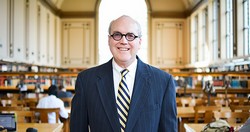One of the most prominent issues in society today is the elevating cost of education, according to many students. Tuition at all public colleges came to $62.6 billion in 2012.
Some universities are taking a stance against this issue, including Stanford University.
About three weeks ago, the University stated that students whose families make less than $125,000 a year and have assets worth $300,000 or less won’t have to pay for tuition.
These assets can include home equity, but exclude retirement savings. Students whose families make less than $65,000 are exempt from paying for room and board, which can cost close to another $14,000.
The University will use scholarships or grants to cover these costs, along with Stanford’s $21 billion endowment.
“Our highest priority is that Stanford remain affordable and accessible to the most talented students, regardless of their financial circumstances. Our generous financial aid program accomplishes that, and these enhancements will help even more families, including those in the middle class, afford Stanford without going into debt,” said Provost John Etchemendy in a press release.
Although Stanford is making this change, their tuition has raised 13 percent in the last five years.
Now, according to Stanford, 77 percent of its students graduate with no debt, where about 70 percent of other students graduate owing an average of $29,000.
Over 30 percent of those who have begun to make their loan payments are behind more than three months. Student loan debt has tripled over the last decade.
Before this change, the requirements for free tuition was for families who made under $100,000 for free tuition and $60,000 for free room and board.
Stanford students will still have to pay at least $5,000 per year from working either during the school year, the summer, or their savings.
Princeton University is another institution implicating changes like this. They offer free tuition to students whose parents make less than $120,000 a year, and free room and board to those who make under $60,000.
Harvard University offers free tuition for families who make less than $65,000, but asks those who make between $65,000 and $150,000 to pay between 0-10 percent of their income to the school.
In January, President Barack Obama proposed a plan that would cover tuition costs for all high school graduates with a 2.5 GPA that enroll full-time or half-time in community colleges and are headed toward a four-year degree.
“As someone who’s coming out of college worrying about debt and paying back my student loans, I think this is a great thing these Ivy League, private schools are doing, and I wish it was an option for this private University,” said junior social work student Rachel Gale.
At Monmouth University, the only students who are exempt from paying tuition are athletes who have been awarded a full athletic scholarship, and children of employees that enter Monmouth through the tuition remission program.
The tuition remission program still requires families to pay the tax on Monmouth’s tuition, according to undergraduate admission counselor Emma Caban. Some students might be able to cover their tuition with a combination of grants from Monmouth, federal, and state.
“This is a good idea and schools like Harvard and Princeton have been doing this for years but they also have an endowment much higher than the average university, which allows them to do so,” said senior accounting student Elias Peralta.
“I think there should be more action taken by the government to address the issue or else we’re going to have low and middle classes incurring debt that’s going to take them a significant portion of their lives to pay, even more so than it already does,” Peralta said.



